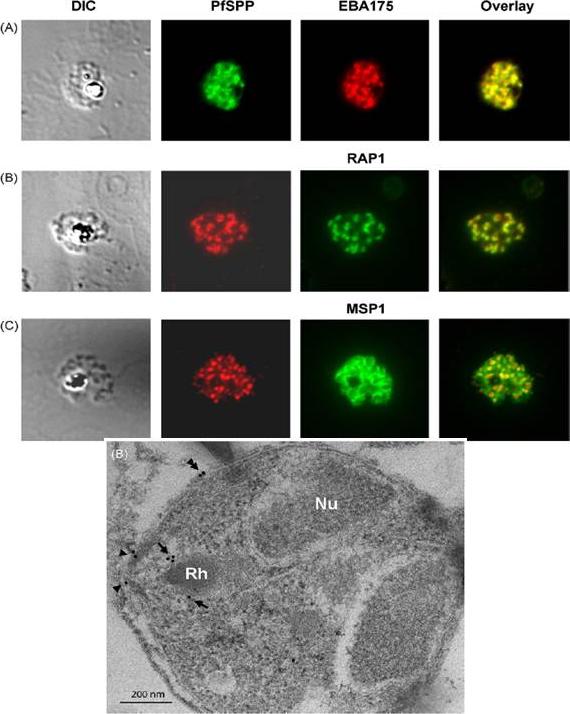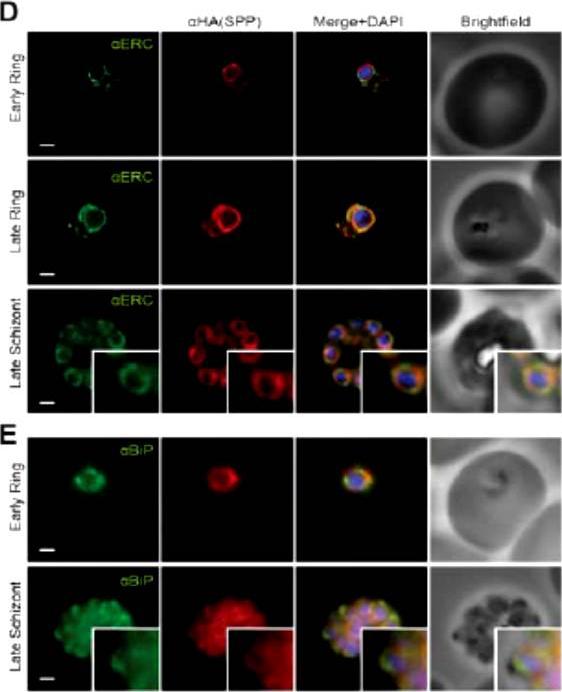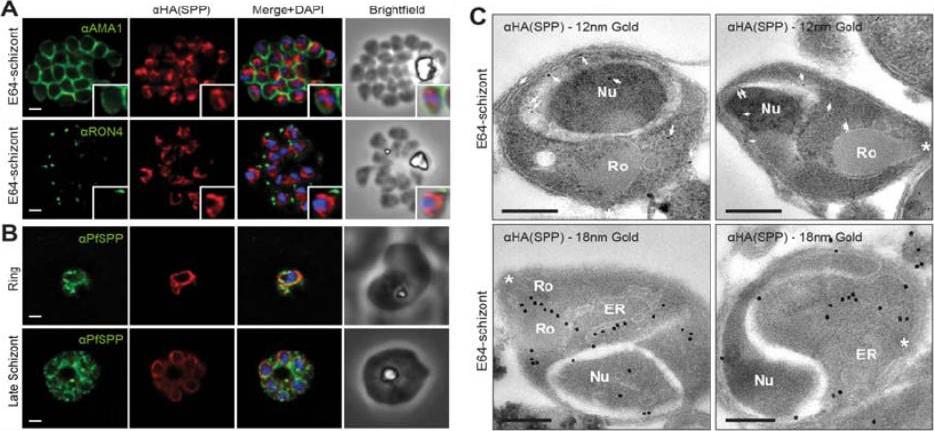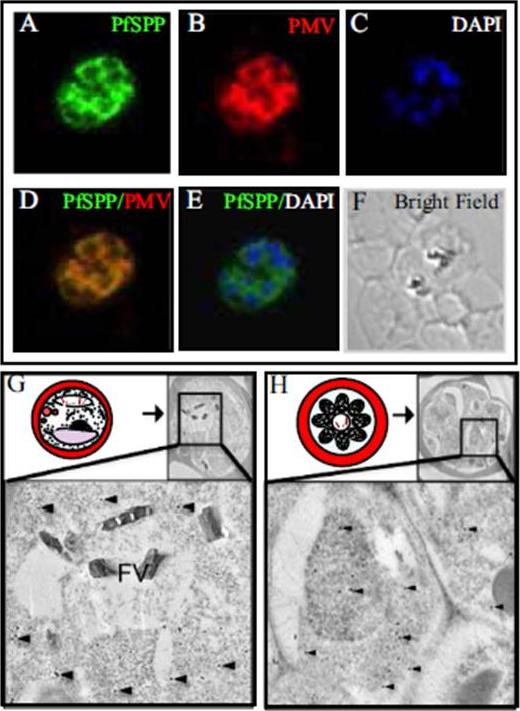PCHAS_1324000 signal peptide peptidase, putative (SPP)
Disruptability [+]
| Species | Disruptability | Reference | Submitter | |
|---|---|---|---|---|
| P. berghei ANKA |
Refractory |
RMgm-883 | Imported from RMgmDB | |
| P. berghei ANKA |
Refractory |
PlasmoGEM (Barseq) | PlasmoGEM | |
| P. falciparum 3D7 |
Possible |
USF piggyBac screen (Insert. mut.) | USF PiggyBac Screen | |
Mutant phenotypes [+]
None reported yet. Please press the '+' button above to add one.Imaging data (from Malaria Metabolic Pathways)

Co-localization of PfSPP in mature P. falciparum. Indirect immunofluorescence microscopy using specific antibodies showed PfSPP is co-localized with EBA-175 MAL7P1.176 (a microneme protein), but neither with RAP1 PFE0080c (a rhoptry marker) nor MSP1 PFI1475w (merozoite surface protein) in the P. falciparum (3D7) chizonts. PfSPP is expressed in the micronemes of mature parasites. The anti-PfSPP Abs showed specific labeling of the merozoite with gold particles in the micronemes (arrows), the apical surface area (arrowheads). The parasite nucleus (Nu), rhoptries (Rh) are indicated.Li X, Chen H, Oh SS, Chishti AH. A Presenilin-like protease associated with Plasmodium falciparum micronemes is involved in erythrocyte invasion. Mol Biochem Parasitol. 2008 158:22-31. Copyright Elsevier 2009.
See original on MMP
PfSPP localises to the parasite nuclear periphery. IFA of ring, trophozite and schizont stages of PfSPP-HA labeled with anti-PfERC and HA antibodies. Scale bar 1 μm. Co-labeling with ER markers BiP and ER-calcium binding protein (ERC) by IFA showed strong coincidental labeling with PfSPP fluorescence across the entire intra-erythrocytic development of the parasite. SPP is localized to the ER.Marapana DS, Wilson DW, Zuccala ES, Dekiwadia CD, Beeson JG, Ralph SA, Baum J. Malaria parasite signal peptide peptidase is an ER-resident protease required for growth but not invasion. Traffic. 2012 13(11):1457-65
See original on MMP
PfSPP localises to the parasite nuclear periphery.(A) IFA of E64 treated PfSPP-HA schizonts labeled with anti-PfAMA1, PfRON4 and HA antibodies. Scale bar 1 μm. Inset displays magnification of single merozoite. (B) IFA of ring and late schizont stage PfSPP-HA parasites labeled with anti-PfSPP and HA antibodies. Scale bar 1 mm. (C) Immuno-electron micrograph of E64 treated PfSPP-HA schizonts with 12 nm or 18 nm immunogold. Arrowheads mark 12 nm immunogold labels and white asterisks marks parasite apex. Nucleus (Nu), endoplasmic reticulum (ER) and rhoptry (Ro). Scale bar = 200 nm. PfSPP is an ER-resident peptidase that remains intracellular throughout the invasion process.Marapana DS, Wilson DW, Zuccala ES, Dekiwadia CD, Beeson JG, Ralph SA, Baum J. Malaria parasite signal peptide peptidase is an ER-resident protease required for growth but not invasion. Traffic. 2012 13(11):1457-65
See original on MMP
Co-localization of PfSPP (signal peptide peptidase) and Plasmepsin V in the endoplasmic reticulum. Indirect immunofluorescence microscopy using specific antibodies demonstrates PfSPP (green) co-localizes with a known parasite ER marker Plasmepsin V (red) in the Plasmodium falciparum (3D7) trophozoite. (A) Staining of PfSPP. (B) Staining of known ER marker, Plasmepsin V. (C) DAPI stain. (D) PfSPP and PMV overlay. (E) Overlay of PfSPP and DAPI stain. (F) Bright field microscopy. (G and H) Immunogold electron microscopy of PfSPP in the parasite infected erythrocytes. PfSPP is indicated by black dots and several spots are identified by black arrowheads. (G) Schematic illustration of a mature trophozoite stage parasite in the infected. PfSPP staining in the trophozoite shows a diffuse staining pattern throughout the perinuclear endomembrane system/ER. (H) Illustration of a late schizont-stage parasite in an infected erythrocyte. PfSPP staining in the late-schizont stage of parasite development shows staining throughout the perinuclear endomembrane system/ER. Baldwin M, Russo C, Li X, Chishti AH. Plasmodium falciparum signal peptide peptidase cleaves malaria heat shock protein 101 (HSP101). Implications for gametocytogenesis. Biochem Biophys Res Commun. 2014 Jul 10 [Epub ahead of print]
See original on MMPMore information
| PlasmoDB | PCHAS_1324000 |
| GeneDB | PCHAS_1324000 |
| Malaria Metabolic Pathways | Localisation images Pathways mapped to |
| Previous ID(s) | PC300096.00.0, PCAS_132400, PCHAS_132400 |
| Orthologs | PBANKA_1320700 , PF3D7_1457000 , PKNH_1224800 , PVP01_1249900 , PVX_117615 , PY17X_1324500 |
| Google Scholar | Search for all mentions of this gene |